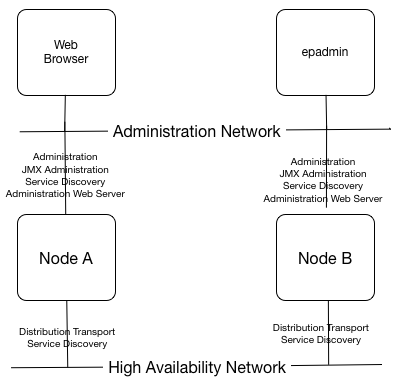When installing and starting one or more TIBCO Streaming nodes, either in StreamBase Studio or at the
command line with the epadmin command,
the StreamBase Runtime opens
multiple TCP and UDP ports for outgoing and incoming traffic. This is to provide
channels for node communication and administration, and to allow node-to-node
communication. These ports are required even when nodes are installed on a single
machine using the hostname localhost.
To connect to a node running on a remote machine, the epadmin command allows you to specify:
-
The hostname parameter to specify the DNS name or IP address of the remote machine.
-
The adminport parameter to specify the administration port for that node.
Use a command like the following to determine a node's administration port:
epadmin servicename=nodename.clusternamedisplay node | grep Admin [macOS, Linux] epadmin servicename=nodename.clusternamedisplay node | findstr Admin [Windows]
If you have configured the node with a node-specific username and password, you may have to specify that those parameters as well.
Some development or server machines may experience port blocking by their firewall software. If it is not feasible to disable the local firewall, you can configure the firewall to allow incoming traffic as follows:
| Program to allow through | Port Function | Protocol | Ports Required |
|---|---|---|---|
| epadmin | Node administration | SSL using IPv4 or IPv6 | Randomly assigned valid free port per node. |
| Web browser | Node administration web server | SSL or TCP using IPv4 | Randomly assigned valid free port per node, with allocation starting at 8008. |
| DtmEngine | Distribution transport | SSL or TCP using IPv4, IPv6 or IPoSDP (Infiniband) | Randomly assigned valid free port per node. |
| swcoord | Service discovery | UDP broadcast over IPv4 | 54321 |
| Any JMX-compliant network manager | JMX administration | TCP over IPv4 | Randomly assigned valid free port per engine. |
The following diagram shows how the required network ports are used to communicate between nodes and administration clients.

|
Configure node port settings in the NodeDeploy root object of the node configuration configuration type. These settings are described in more detail in the Runtime Admin Guide [cross-ref], as follows:
| Port Function | Nodedeploy object |
|---|---|
| Node administration, and web server administration | Administration [cross-ref] |
| Distribution transport | DistributionListenerInterface [cross-ref] |
| Service discovery | Communication [cross-ref] |
